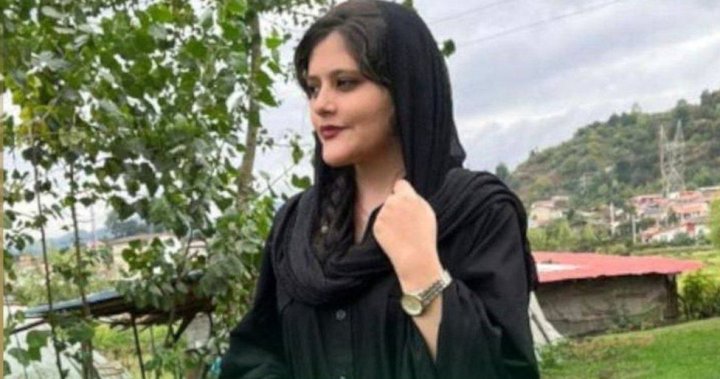Global News revisits the one-year milestone of the Women, Life, Freedom movement that emerged following the tragic death of Mahsa Jina Amini while in custody. This groundbreaking revolution in Iran is led by courageous women who pose a significant challenge to the long-standing Islamic Republic regime that has governed the country since 1979. The movement began when Mahsa Jina Amini, a 22-year-old woman from Saqqez in the Kurdish region of Iran, was arrested by the morality police for allegedly violating hijab rules. Tragically, she fell into a coma during her detention and later died in a Tehran hospital.
Amini’s untimely death provoked shock and anger among the public, resulting in mass gatherings outside the hospital to express their grief. While the police claimed that Amini’s death was due to an underlying medical issue, her family insisted that she had been fatally beaten. This sparked widespread protests across the country demanding justice and accountability, which eventually transformed into a movement seeking the overthrow of the regime.
The funeral of Mahsa Amini in her hometown became a focal point for demonstrations, with women defiantly discarding their mandatory headscarves as an act of rebellion. These protests even reached Canadian soil, as hundreds of Iranian-Canadians rallied outside the U.S. Consulate in Vancouver to condemn Amini’s death. In response, the U.S. government levied sanctions against the morality police, amplifying the calls for action.
The crackdown on dissent extended to Sharif University in Tehran, often referred to as Iran’s MIT, where security forces violently suppressed students through beatings, shootings, and arrests. The regime’s suppression tactics also targeted artists like Iranian singer Shervin Hajipour, who was arrested for supposedly spreading anti-government propaganda through a song that later earned him a Grammy.
The regime’s militarized response escalated in the Kurdish town of Sanandaj, where tanks were deployed to crush the protests in the wake of Mahsa Amini’s death. Adding to the violence, a fire broke out at Evin Prison, resulting in multiple casualties. Human rights advocates suspect the regime deliberately started the fire.
Disturbing reports emerged of Iranian schoolchildren being killed by the regime during the protests. Witnesses, including an Iranian-Canadian woman who participated in the demonstrations, recounted the brutal suppression of protests and security forces directly targeting protesters with gunfire.
To counter the regime’s actions, Iranian-Canadian lawyers collaborated with counterparts in the U.S. and Iran to compile a database of Iranian Revolutionary Guard Corps members and their associates residing in Canada.
The Women, Life, Freedom movement faced its first execution when 23-year-old Mohsen Shekari was hanged. Amnesty International condemned the execution, highlighting the unfair and unjust nature of the regime’s trials.
A second execution linked to the revolutionary movement occurred with the hanging of 23-year-old Majidreza Rahnavard in Mashhad. Human rights organizations argued that these individuals, like many others, were denied due process and sentenced to death after sham trials.
The downing of Ukraine International Airlines Flight PS752, which claimed the lives of all 176 people on board, including Iranian-Canadians, marked a grim milestone three years later. Mourners in Canada and protests in Iran remembered the tragedy and continued to call for regime change.
Human rights organizations documented cases of Iranian security forces intentionally targeting protesters’ eyes during the uprisings. Many victims, such as Saman, a 30-year-old Iranian affected by the regime’s violence, shared their stories, emphasizing both their bravery and the continued need for international support.
The Women, Life, Freedom movement coincided with the celebration of Nowruz, the Persian New Year. Iranians worldwide marked the occasion with mixed emotions of hope and anguish.
Returning from the Nowruz holiday, reports indicated an increase in chemical attacks on Iranian schoolgirls. Thousands of young girls fell ill, experiencing symptoms such as coughing, choking, and difficulty breathing. Many were hospitalized, and activists in Metro Vancouver played a crucial role in documenting and tracking violence against women and girls in Iran.
The United Nations expressed alarm at Iran’s execution spree, with at least 59 people executed in May alone. The UN labeled this record of executions as “abominable.”
Imprisoned Iranian women journalists, Niloofar Hamedi, Elaheh Mohammadi, and Narges Mohammadi, were honored with the prestigious UNESCO/Guillermo Cano World Press Freedom Prize for their fearless reporting. Additionally, three men were executed in Iran on charges related to the Women, Life, Freedom movement.
The anniversary of the hangings of 10 Baha’i women, who were executed four decades ago for refusing to renounce their faith, was marked by the launch of the #OurStoryisOne campaign, commemorating this tragic event in Iran’s history.
Canada, Sweden, Ukraine, and the United Kingdom took Iran to the International Court of Justice over the downing of PS752, seeking justice for their citizens who perished in the tragic incident.
Rights advocates condemned Iran’s morality police for their increased enforcement of gender apartheid, which resulted in further restrictions on women’s rights.
Although the death sentence for dissident rapper Toomaj Salehi was overturned, he faced over six years in prison for his activism. Salehi’s case highlighted the regime’s suppression of freedom of expression.
Through these events, the Women, Life, Freedom movement continues to persevere and demonstrate the resilience and determination of Iranians seeking a brighter future.
Denial of responsibility! Vigour Times is an automatic aggregator of Global media. In each content, the hyperlink to the primary source is specified. All trademarks belong to their rightful owners, and all materials to their authors. For any complaint, please reach us at – [email protected]. We will take necessary action within 24 hours.


